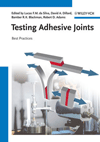Hotmelts are ideal for bonding porous substrates.
Hotmelt adhesives are a general class of thermoplastic materials that melt and flow when heated. Some hotmelts are also thermosets, but most are relatively high molecular weight thermoplastics. They are applied as molten liquids and, upon cooling, regain their inherent strength and bond two materials together.
Hotmelts, along with starch-based and protein-based natural products, are among the oldest adhesives. Early hotmelts, derived from natural waxes and tree gums (rosin), may have been used by the ancient Egyptians. We are told Noah used pitch to seal the Ark. Modern hotmelts began with rubber-based adhesives and many hotmelts today are based on styrene-butadiene-styrene, styrene-isoprene-styrene, or styrene-ethylene-butadiene-styrene.
In a rubber-based hotmelt formulation, synthetic polymers provide inherent strength. Hotmelts may contain a tackifier for pressure sensitivity, compatibilizers for homogeneity, and wax, oil or filler as tack modifiers. High filler levels are rarely used. Other rubber bases include acrylics, urethanes and silicones. Simple thermoplastics are also used including olefin copolymers, ethylene vinyl acetate, metallocene polyethylene, polyesters, and polyamides. Instead of being blends, many of these derive from mixed monomers to produce blocky copolymers having rigid and flexible chain segments. The latter two have high, sharp melting points making them suitable for some higher temperature applications.
One of the most studied phenomena in the adhesives industry is how hotmelts stick. As with all adhesives, surface wetting is vitally important. Pressure sensitive adhesives (PSA) have little tolerance for surface oil, moisture, or dust but they stick well to almost all clean surfaces. Application to a “cold” surface freezes the material quickly, which reduces wetting.
Hotmelts are rarely applied directly to heat-conductive surfaces such as metals. Clean metals can be joined with converted pressure-sensitive tapes. Preheated metals can be joined with direct-applied hotmelts and metals can also be primed with reactive species allowing the hotmelt to reactively bond to the surface.
Nonconductive surfaces are far more forgiving and most direct-applied hotmelts are used on paper, plastic or films, often to produce laminations and tapes. Fibrous substrates provide a lot of surface area for wetting and penetration by the hotmelt. Wetting is influenced by the melt viscosity of the adhesive. While the melt viscosity can be decreased by increasing the application temperature, excessive temperature leads to oxidation, degradation, discoloration and char from free-radical cross-linking.
Applications abound. Many pressure-sensitive tapes derive from converted hotmelt adhesives applied to different backer films and papers. The adhesive polymer chemistries and formulating ranges are very broad, giving rise to thousands of products and uses. Some PSA tapes are truly structural and find applications in primary load management for automotive, aerospace and marine applications.
One of the first adhesive industries to appear in developing countries is a converting facility to produce tapes. Similarly, one of the first questions asked about a new adhesive technology is: “Can you make that into a tape?” Several companies in the United States specialize in producing tapes or a converted product from hotmelts. Some develop their own adhesives but all do specialty converting.
The packaging industry thrives on hotmelts. Carton sealing depends on tapes or hotmelt sealer guns. If it’s just a letter, envelopes and stamps are peel-n-stick. When it absolutely, positively has to be there by tomorrow, a hotmelt adhesive is probably getting it there.
The laminated packaging industry depends heavily on hotmelts for medical products, personal hygiene products, and food packaging structures. Hotmelts are the basis for many heat seal formulations used extensively in snack food, meat and cheese, and condiment packaging.
The nonreactive materials found in hotmelt adhesives have low toxicity, which simplifies plant hygiene and disposal. Equipment can be idled easily for shut downs and simply restarted when production resumes. Some hotmelts are reactive, usually crosslinked from airborne moisture, and are handled under dry nitrogen. The reactive species attached to high molecular weight polymers represent little hazard. Reactive hotmelts approximately double in strength with time and have found many uses in the furniture and assembly industries.
A huge assortment of hotmelt products are available today at relatively low cost. Sophisticated application equipment is readily available allowing for rapid throughput. With their inherent low toxicity, hotmelt adhesives enjoy widespread use either directly or as converted products. Sometimes, old ways are best.


